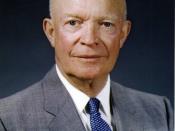Conformity is defined in the dictionary as a correspondence in form or character agreement. This correspondence and agreement was something that understandably took away from the individual and more or less "conformed" society in the 50's. The 1950's deserves its reputation as an age of political, social, and cultural conformity to a great extent. Eisenhower's actions to improve old policies were indeed a political conformity. Society was being surrounded with leisure activities that no doubt accepted the customs of its culture.
During the decade of 1950, American citizens desired for a decisive leadership. The president was ready to support and lead the nation. Ike was leading the country by his philosophy in which he believed that he should be liberal with people and conservative with their economy. Ike supported the Highway Act of 1956 which resulted in $27 billion dollars to build 42,000 miles of highways. Eisenhower practiced "the politics of tranquility" a new executive style that was quite different from the social activism of Roosevelt and Truman.
Americans of both generations were eager to pursue the politics of tranquility.
Social conformity was also being played out during the 1950s. During the 1950s, America's Gross National Product increased 51%. GIs returning from World War II and Korea were eager to spend money and to have children. In the 1950s, 29 million new Americans were born. The birth rate of the United States was comparable to that of India. To meet the consumer demands of this increasing population, American industry expanded at an amazing pace and turned out new cars, clothing, Frisbees, and a plethora of other consumer items. During the 50s, women faced terrific hostility as many were convinced that the female's place was in the home, their actions were acceptable and met the traditional values of the nation.
Cultural conformity was also an aspect of the 1950's. The role of women and men and/or teen culture evolved. In the 1950's the "American Dream", meant a home in the suburbs a job security in a large corporation, and a new car every few years. Innovations such as: the T.V, credit cards, "fast food", and entertainment parks, all these arose to a new lifestyle. The T.V has added 436 channels since it first started in 1946. Television broadcasted everything from religion to propaganda, sports and revolutionized people into wanting to stay home to watch TV. The Credit Card was first introduces by the Diner's club, and it was plastic. Fast food was introduced by McDonald's. Disneyland first opened as an entertainment park. Even though, there were many changes the public remained up to the title: the age of conformity.
The decade of the 1950's was an age of political, social, and cultural conformity. As any decade does, the 1950s looked back to the solidarity of World War II caused the public to be calm and accept the rules of society. The 1950's predicted the multiple explosions of the 1960s.


